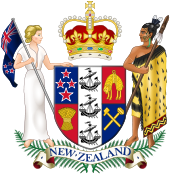- New Zealand Nuclear Free Zone, Disarmament, and Arms Control Act 1987
-
New Zealand Nuclear Free Zone, Disarmament, and Arms Control Act 
Parliament of New ZealandLong title/
PurposeAn Act to establish in New Zealand a Nuclear Free Zone, to promote and encourage an active and effective contribution by New Zealand to the essential process of disarmament and international arms control, and to implement in New Zealand the following treaties:
(e) The Convention on the Prohibition of the Development, Production and Stockpiling of Bacteriological (Biological) and Toxin Weapons and on their Destruction of 10 April 1972 (the text of which is set out in Schedule 5 to this Act):
(a) The South Pacific Nuclear Free Zone Treaty of 6 August 1985 (the text of which is set out in Schedule 1 to this Act):
(b) The Treaty Banning Nuclear Weapon Tests in the Atmosphere, in Outer Space and Under Water of 5 August 1963 (the text of which is set out in Schedule 2 to this Act):
(c) The Treaty on the Non-Proliferation of Nuclear Weapons of 1 July 1968 (the text of which is set out in Schedule 3 to this Act):
(d) The Treaty on the Prohibition of the Emplacement of Nuclear Weapons and Other Weapons of Mass Destruction on the Sea-bed and the Ocean floor and in the Subsoil Thereof of 11 February 1971 (the text of which is set out in Schedule 4 to this Act):Dates Date passed 1987 Date of Royal Assent 8 June 1987 Other legislation Status: Current legislation The New Zealand Nuclear Free Zone, Disarmament, and Arms Control Act is a New Zealand law passed by the Fourth Labour Government in 1987 "to establish in New Zealand a Nuclear Free Zone, to promote and encourage an active and effective contribution by New Zealand to the essential process of disarmament and international arms control"[1]. It also implemented a number of treaties in New Zealand, including the South Pacific Nuclear Free Zone Treaty and the Treaty on the Non-Proliferation of Nuclear Weapons.
Contents
Summary of the Act
The act established the New Zealand Nuclear Free Zone comprising all New Zealand territory (including ocean territory and airspace) and prohibited "entry into the internal waters of New Zealand by any ship whose propulsion is wholly or partly dependent on nuclear power" and banned the dumping of radioactive waste within the nuclear-free zone, as well as prohibiting any New Zealand citizen or resident "to manufacture, acquire, possess, or have any control over any nuclear explosive device." Similar provisions were made for biological weapons. Immunity from the law was granted to ships and aircraft exercising the right of innocent passage and/or the right of transit passage (in accordance with international law). The act established a 'Public Advisory Committee on Disarmament and Arms Control' "To advise the Minister of Foreign Affairs on such aspects of disarmament and arms control matters as it thinks fit." Offences against the act are punishable by imprisonment, "for a term not exceeding 10 years".[1] It denoted a massive change in New Zealand's nuclear stance, as it now completely banned any association with nuclear weapons.
Background
In the context of a global nuclear free movement caused by mounting Cold War tensions between the United States and the Soviet Union, visits to New Zealand by US navy ships caused publicity and protest. In June 1984 Labour MP Richard Prebble introduced a bill (one of a series since the 1970s) to ban nuclear armed and powered ships, as well as nuclear reactors and waste. The National government at the time had a majority of one, and MP Marilyn Waring crossed the floor to support the nuclear free legislation. Prime Minister Robert Muldoon claimed that Waring's "feminist anti-nuclear stance" threatened his ability to govern, and called a snap election. After winning the election Labour entered office with the intention of declaring New Zealand nuclear free; the party had proposed to renegotiate the ANZUS treaty to incorporate a nuclear free nation. The critical moment in relations with the US came in 1985 when the New Zealand government refused a request from the USA to allow the visit of the non-nuclear destroyer USS Buchanan (DDG-14) on the grounds that it was potentially capable of carrying nuclear weapons. The US subsequently suspended its obligations to New Zealand under the ANZUS treaty.[2]
See also
References
- ^ a b "New Zealand Nuclear Free Zone, Disarmament, and Arms Control Act". http://www.legislation.govt.nz/act/public/1987/0086/latest/DLM115116.html.
- ^ Philippa Mein Smith A Concise History of New Zealand Cambridge University Press, Melbourne, 2005 pp. 216-217
External links
Categories:- New Zealand Statutes
- 1987 in New Zealand
- Nuclear technology in New Zealand
- 1987 in law
- Environmental law in New Zealand
- 1987 in international relations
- 1987 in the environment
Wikimedia Foundation. 2010.
